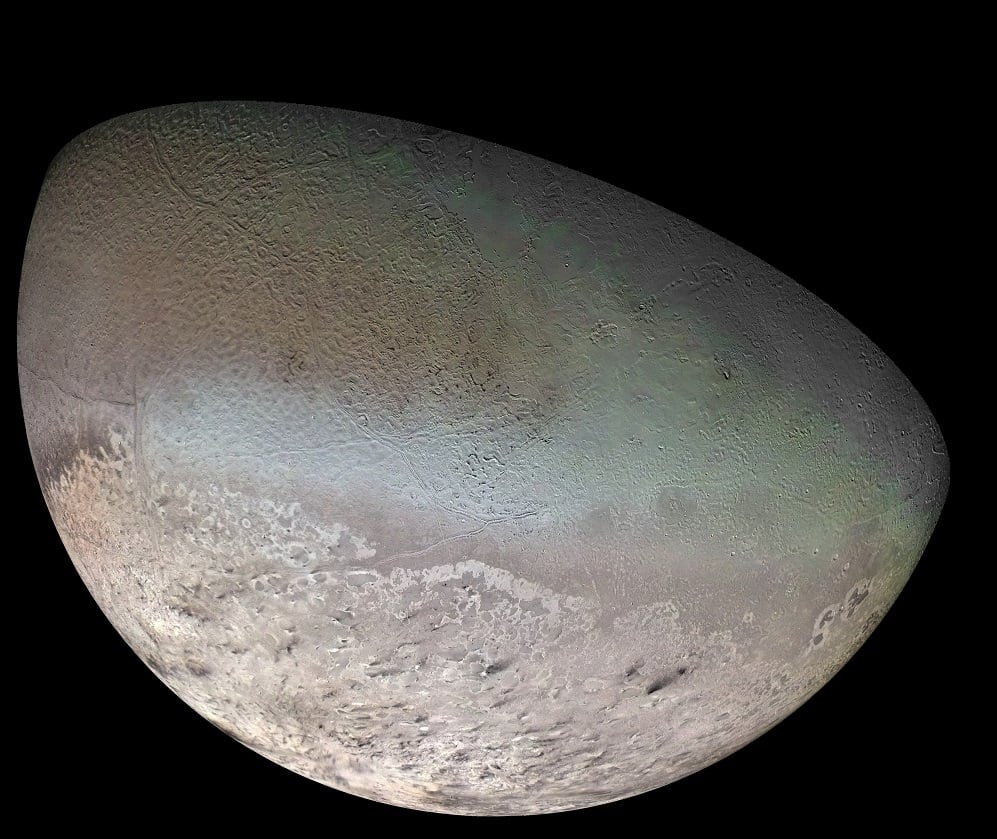We recently examined how and why Saturn's icy moon, Enceladus, could answer the longstanding question: Are we alone? With its interior ocean and geysers of water ice that shoot out tens of kilometers into space that allegedly contains the ingredients for life, this small moon could be a prime target for future astrobiology missions. But Enceladus isn't the only location in our solar system with active geysers, as another small moon near the edge of the solar system shares similar characteristics, as well. This is Neptune's largest moon, Triton, which has been visited only once by NASA's Voyager 2 in 1989. But are Triton’s geysers the only characteristics that make it a good target for astrobiology and finding life beyond Earth?
"Triton may be an 'ocean world', a moon that has a solid ice crust over a liquid water subsurface ocean," said Dr. Candice Hansen-Koharchek, who is a planetary scientist and was a Voyager Imaging Team Assistant Experiment Representative during the Voyager missions. "If that is the case, and if we are able someday to reach that ocean and find life, that would extend the habitable zone to the Kuiper Belt, not just the inner solar system. That has profound implications, both in our solar system and at exoplanets."
Due to its geysers, which Voyager 2 identified as dark streaks, Triton is only the third known planetary body in the solar system to be volcanically active, aside from Earth and Jupiter's innermost Galilean moon, Io. Unlike the geysers of Enceladus, which is believed to be caused through tidal heating, Triton's geysers are the result of solar heating, where the dim sunlight that reaches the moon causes the frozen nitrogen on the surface to slowly melt and eventually erupt. The active geology also explains the lack of craters on its surface, as well, and it turns out that Triton holds another feature similar to Earth.
"Triton has a nitrogen atmosphere that freezes into polar caps seasonally," said Dr. Hansen-Koharchek. "The Earth also has a mainly nitrogen atmosphere - can you imagine if our atmosphere froze onto the ground in the winter?! Although Triton's atmosphere is thin, winds blow and scatter particulates across the surface."
As stated, Voyager 2 is the only spacecraft to have visited Triton, but another NASA mission known as TRIDENT was selected as a finalist in 2020 to explore Triton up close for the first time since 1989, but was ultimately passed over in the final selection round by NASA in 2021.
"Trident would have established the existence of a subsurface ocean - the first step in reconnaissance of an ocean world," said Dr. Hansen-Koharchek. "Trident carried a near-infrared spectrometer, which would have allowed us for the first time to map the distribution of ices (N2, CH4, CO, CO2, and H2O) across its surface (Voyager did not carry a near-IR spectrometer so all we know about the composition is what we can glean from Earth)."
For now, Triton orbits Neptune near the edge of the solar system with its active geysers, nitrogen atmosphere, and possible interior ocean. When will we visit it again, and does this active moon harbor life as we know it due to its unique features?
And with this, we wonder if Triton will finally answer, "Are we alone?"
As always, keep doing science & keep looking up!
 Universe Today
Universe Today
